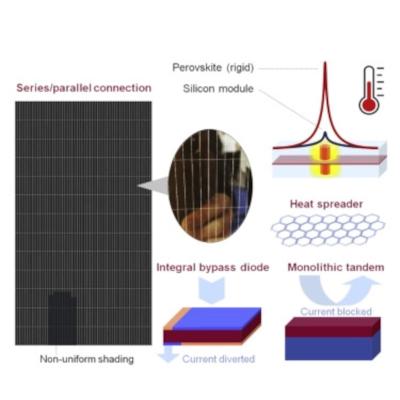University of New South Wales (UNSW) team, led by renowned PV scientist Martin Green, have shown that perovskite solar cells may be especially susceptible to damage from reverse bias, caused by uneven shading or other issues that may appear in real-world environments. Both the reverse-bias itself and resulting build up of heat can cause several of the materials commonly used in perovskite solar cells to degrade, and these issues have received only limited attention in research published thus far.
Stability issues with perovskite solar cells linger, despite impressive research achievements in the last few years. Much of the research focused on improving stability to date has focused on the issues that arise under normal operating conditions – for example sensitivity to oxygen and moisture, which can be solved through encapsulation, or degradation under UV light, which can be solved with reflective coatings. Other issues, however, may present serious challenges to developing perovskite devices that can function in outdoor conditions for years and even decades. “…thermal degradation and reverse-bias instability are remaining issues that pose challenges even for intrinsically much more stable silicon cells, suggesting that innovative approaches may be required to satisfactorily address these for perovskite cells”, explain the authors of the new paper.
Reverse bias can be caused when an individual cell is shaded and other cells in the module try to push a higher current through it. Recent research has shown this itself can cause damage to the shaded cell, and lead to an increase in temperature, causing further damage. The new research by UNSW outlines how perovskite solar cells are vulnerable to this problem, particularly since they typically dissipate heat much more slowly than silicon, and many of the typical component materials can begin to degrade at temperatures as low as 60 C. In the paper, UNSW scientists Dongchen Lan and Martin Green detail the vulnerabilities relating to reverse bias in full, and suggest solutions.
Since making the materials less susceptible to reverse bias damage would be very difficult, the scientists first recommend design approaches that would simply avoid the risk of it occurring: Adding a bypass diode to each individual cell would offer significant protection, and if combined with altering the module interconnection layout so that current flows across the cell widths, and possibly an additional component to aid in heat dissipation, Lan estimates that this should limit temperature increases to 40 C in most field situations.
In for perovskite-silicon tandem cells, in particular, tuning the bandgap of the perovskite cell, to make it slightly lower than the optimal value to match the current in the silicon, could be another effective strategy without significant costs. “This is to prevent the silicon cell generating substantially more current than the perovskite cell under some conditions, driving it into reverse bias.”


